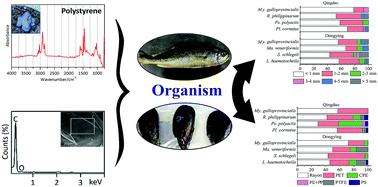Detection of microplastics in local marine organisms using a multi-technology system
Abstract
Microplastics with complex polymer compositions are present in a lot of marine organisms. In this study, successive stereo microscopy and micro-Fourier transform infrared spectroscopy equipped with attenuated total reflection (μ-ATR-FTIR) in combination with scanning electron microscopy-energy dispersive spectroscopy (SEM-EDS) were implemented to establish a highly accurate microplastics detection system. The method was applied to analyze microplastics in both the soft tissue and the digestive tract of bivalves and fish collected from the markets in Qingdao and Dongying. The results showed that the individual detection rate of microplastics was higher in the fish than that in the bivalves and that the abundance of microplastics measured in items per individual was significantly higher in the fish than that in the bivalves. Four shapes of microplastics, including fibers, fragments, granules and films, were separated from the organisms above. Fibrous microplastics, being the most dominant ones, accounted for over 70% in different organisms. The average size of the fibrous microplastics was smaller than that of the other three shapes of microplastics. The number of microplastics decreased with increasing microplastics sizes. Microplastics of less than 1 mm obtained from different organisms were in the range of 43% to 78%. Rayon (a semi-synthetic polymer) was the most predominant polymer type of microplastics found, accounting for 48.92%. The demersal fish contained relatively more rayon compared with the pelagic fish samples. Surface chemical components of the microplastics were altered possibly owing to the abiotic oxidation. Large variations of the weathering morphologies were observed in the surface of the differently shaped microplastics originating from the organisms. Some microplastics exhibited a rough surface, broken margins, and pronounced pores. SEM-EDS, as an auxiliary technology, would provide a way for data calibration in microplastics investigation. The combination method can provide complementary data and therefore can be successfully applied to accurately identify microplastics.

- This article is part of the themed collection: In celebration of Chinese New Year 2020


 Please wait while we load your content...
Please wait while we load your content...